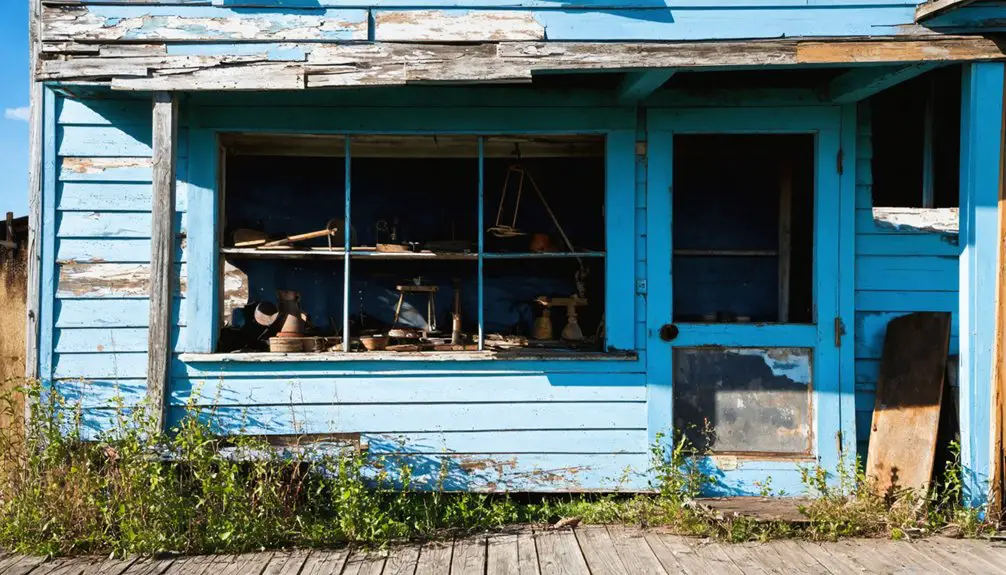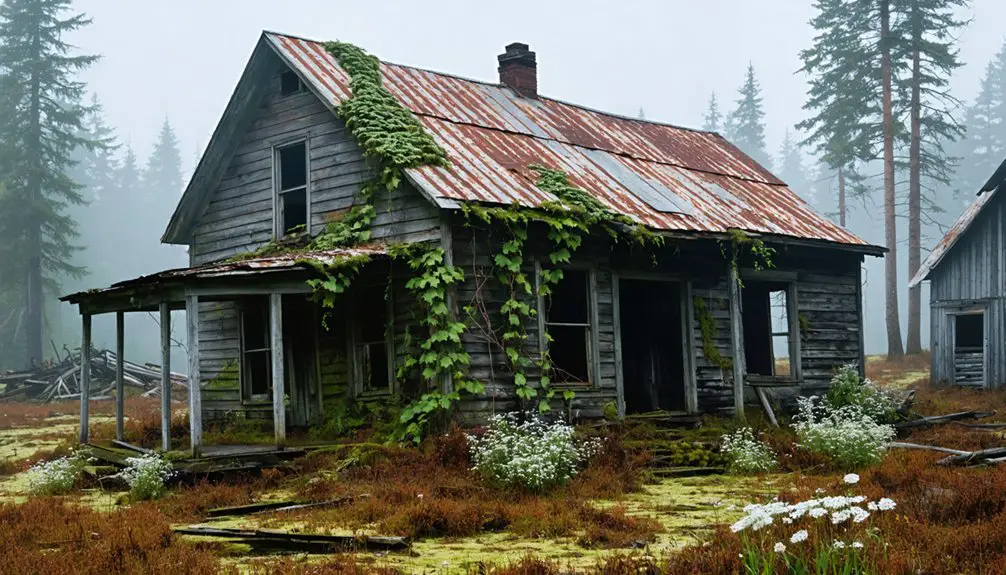You’ll find Oregon’s legendary Greenback Mine in Josephine County, where it produced over $3.5 million in gold between 1897 and 1908. Unlike typical mining towns, Greenback operated as a strict temperance community, where families and merchants lived alongside miners working the rich quartz veins. Though the post office closed in 1908 marking its decline, you can still explore the crumbling foundations and weathered mining tunnels that reveal fascinating stories of frontier life.
Key Takeaways
- Greenback, Oregon was a temperance mining town established in 1897 that became the state’s second-largest gold producer before abandonment.
- The town flourished from 1902-1908, with its gold mine yielding over $3.5 million before declining and becoming a ghost town.
- Unlike typical mining towns, Greenback prohibited alcohol and focused on family values, churches, and schools rather than saloon culture.
- The town’s rapid decline began after 1908, marked by the closure of its post office and residents leaving for new opportunities.
- Today, only crumbling foundations and weathered mining tunnels remain, preserved by local heritage groups as historical landmarks.
The Rise of Oregon’s Richest Mine
When Len Browning and Edward Hanum began the Greenback Mine in 1897, they couldn’t have imagined it would become Oregon’s most profitable gold operation per foot of tunnel.
Within a year, they’d sold their discovery for $30,000, setting off a series of mine ownership changes that would define the region’s gold rush era. The term greenback had multiple meanings during this period, referring to both the mine and paper currency.
Just months after striking gold, Browning and Hanum’s quick $30,000 sale sparked a flurry of ownership transitions in Oregon’s mining landscape.
You can trace the mine’s meteoric rise through its impressive gold extraction numbers. The operation yielded over $3.5 million in recorded gold, with annual production reaching $300,000 in the early 1900s – nearly half of Oregon’s credited mint gold.
The rich quartz vein, averaging $18 per ton across an 8-foot width, proved so valuable that even the waste dumps yielded a daily gold brick when reprocessed by a miner named Klumph over two years. The mine’s success led to significant expansions, including an upgrade to forty stamps in its mill for increased ore processing capacity.
Life in a Temperance Mining Town
Unlike typical mining camps of the era, Greenback stood apart as a temperance town where strict prohibitions against alcohol shaped daily life.
You’d find a community built on temperance values, where families and miners lived alongside merchants in modest wooden homes. Daily routines revolved around mine shifts, church gatherings, and family events rather than the saloons common elsewhere. Local leaders maintained community cohesion through social pressure and ordinances, creating an orderly environment that attracted those seeking stability. Similar to how gold discovery patterns influenced other settlements, residents often relocated when new strikes were found. The town’s decline mirrored that of Black Rock, which was eventually incorporated into the U.S. tree farm system.
- Schools and churches served as social anchors, replacing the role saloons played in other mining camps.
- Clean streets and maintained public spaces reflected the town’s moral character.
- Family-focused commerce thrived instead of typical mining camp entertainment.
- Community gatherings centered on temperance meetings and church events.
- Seasonal mining success determined population stability and economic growth.
Mining Operations and Economic Impact
Established in 1897 by Len Browning and Edward Hanum, the Greenback Mine quickly emerged as Oregon’s second-largest gold producer, revolutionizing the region’s mining industry.
You’ll find evidence of their cutting-edge economic strategies in the massive infrastructure investments, including a 7,000-foot aerial tram and advanced mining technologies like the 12×14 air compressor and multiple Ri’sdon crushers.
The mine’s twelve levels of extensive tunneling reached depths of 350 feet, where miners extracted gold from veins averaging 20 inches wide. The operation’s remarkable success was evidenced when they produced $3500 in cleanups during peak production periods.
Deep within the Greenback Mine, twelve distinct levels snaked through earth and stone, following rich veins of precious gold.
Within just three months of its 1930s reopening, you’d have seen $10,000 in gold flowing through local banks, with single gold bricks worth up to $2,500.
The operation’s success transformed Josephine County’s economy, spurring population growth and establishing the town of Greenback itself.
From Boom to Abandonment
If you’d visited Greenback in 1902, you’d have found a bustling mining town full of optimistic workers drawn to the rich Greenback Mine.
Under the oversight of Carey Thompson, the town maintained strict regulations and orderly development to support its growing population.
Like other mining communities of the era that faced population decline, the town’s fortunes faded as residents sought opportunities elsewhere.
Within six years, the town’s dreams of sustained prosperity crumbled as the post office closed in 1908, signaling the community’s rapid decline.
The combination of depleted ore, shifting mining economics, and the town’s complete dependence on a single industry sealed Greenback’s fate as yet another Oregon ghost town.
Mining Dreams Fade Away
Despite initial prosperity from gold extraction, Greenback’s mining operations began faltering in the early 1900s as operational challenges mounted and ore quality diminished.
Even with mining innovations like advanced tunneling and new milling equipment, you’d have seen the town’s economic resilience tested by rising operational costs and declining returns. Like many operations of the era facing water scarcity, mining efforts were frequently interrupted during dry seasons. A $30,000 investment in 1936 couldn’t reverse the mine’s fortune, and by 1979, only sporadic activity remained under Wes Pieren’s ownership.
The area faced similar challenges to those seen in the John Day gold fields, where depleted deposits forced miners to seek opportunities elsewhere.
- Seasonal water constraints limited continuous mining operations
- Complex geology increased extraction costs and reduced ore recovery
- Post office closure by 1908 signaled rapid population decline
- Lack of economic diversification left the town vulnerable to mining downturns
- Attempts at revival never matched the early boom period’s success
Gold Rush Gone Cold
Once the bustling heart of Oregon’s gold mining operations, Greenback’s dramatic transformation into a ghost town unfolded between 1902 and 1908.
Gold was likely discovered in Graves and Wolf Creeks around 1860, setting the stage for decades of mining activity.
You’d have seen the shift from profitable placer mining to more complex lode mining operations, which spelled trouble for the town’s economic sustainability. While the Greenback Mine was renowned for its extensive tunnels, the costs of operation began outweighing the returns.
By the time World War II rolled around, gold production had dwindled to a mere 100-200 ounces annually. Without a diverse economy beyond mining, the town couldn’t survive.
The post office’s closure in 1908 marked the beginning of the end, and Greenback joined countless other mining communities that couldn’t adapt when the gold rush went cold.
Remnants and Historical Legacy

The remnants of Greenback, Oregon paint a stark portrait of the American West’s mining legacy. You’ll find archaeological finds scattered across the landscape – from crumbling foundations to weathered mining tunnels that once yielded over a million dollars in gold.
Community narratives and historical records tell of a unique town where founder Carey W. Thompson banned saloons, forcing residents to venture to nearby Placer for entertainment.
- Original mining trails and road traces reveal the town’s strategic layout
- Historical documents preserve the story of Oregon’s richest gold mine per tunnel foot
- Census records and post office operations (1902-1908) validate the town’s brief existence
- Metal detecting and hiking opportunities keep the site’s spirit alive
- Local heritage groups work to protect these fragments of frontier history
Daily Life and Social Dynamics
Life in Greenback defied typical mining town stereotypes, as founder William Brevoot established strict controls that prohibited saloons and alcohol establishments.
You’d find miners forging tight-knit social networks underground during their grueling shifts, while their families maintained community interactions above ground.
When you wanted entertainment or a drink, you’d head to nearby Placer, where several saloons offered the diversions absent in Greenback.
The town’s small population, likely numbering in the low hundreds, meant you’d know most of your neighbors well.
Daily routines centered around the mine’s schedule, with workers spending long hours excavating tunnels and processing ore.
Mining life revolved around endless shifts underground, as workers devoted themselves to the demanding cycle of excavation and processing.
Despite the limitations on local entertainment, you’d find residents creating their own social activities and forming coalitions to support each other in this isolated mining community.
Frequently Asked Questions
Are There Any Dangerous Areas or Hazards When Visiting Greenback Today?
Like an old miner’s trap, you’ll face hazardous terrain with unstable structures, hidden shafts, and wildlife encounters. Watch for collapsing buildings, poisonous snakes, and limited cell service in remote areas.
What Natural Wildlife Can Visitors Expect to Encounter Around Greenback?
You’ll find remarkable wildlife diversity, from lesser goldfinches and deer to elusive mountain beavers. Keep your eyes peeled for bird watching opportunities and listen for the distinct tee-yee calls.
Is Camping Allowed Near the Greenback Ghost Town Site?
You can camp near the site following state forest camping regulations. While there aren’t designated campsites directly at Greenback, you’ll find dispersed camping opportunities in the surrounding forest areas.
What Is the Best Time of Year to Visit Greenback?
Like a prospector choosing the perfect claim, you’ll find late spring to early fall ideal, when seasonal events align with dry weather. You’ll dodge winter’s muddy roads and summer’s peak crowds.
Are Metal Detecting or Artifact Collecting Activities Permitted at Greenback?
You’ll need explicit permission before metal detecting or collecting artifacts here due to strict regulations protecting historic sites. Contact local authorities first to avoid violating federal artifact recovery guidelines and facing penalties.
References
- https://en.wikipedia.org/wiki/Greenback
- https://heritagedata.prd.state.or.us/historic/index.cfm?do=v.dsp_siteSummary&resultDisplay=42084
- https://en.wikipedia.org/wiki/List_of_ghost_towns_in_Oregon
- https://www.southernoregon.org/cities/cave-junction/culture-history/ghost-towns/greenback/
- https://www.ijpr.org/show/as-it-was/2015-09-14/town-of-placer-serves-as-mining-center-in-josephine-county
- https://www.oregon.gov/dogami/milo/archive/HistoricalSociety/Josephine/MillionsInGold.pdf
- https://truwe.sohs.org/files/miningnotese.html
- https://truwe.sohs.org/files/miningnotesd.html
- https://www.oregon.gov/dogami/milo/archive/MiningDistricts/JosephineCounty/GreenbackDistrict/Greenback/GreenBackMineNews.pdf
- https://www.oregonencyclopedia.org/articles/ghost_towns_illinois_river_valley/



